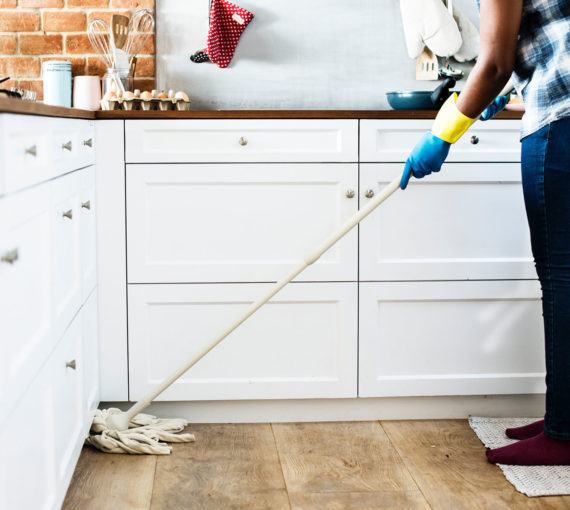
Want to start making your own home green cleaning products? Many are easy to whip up from ingredients right in your cupboard! (Photo: Jess Bailey via Unsplash)
The grocery store cleaning product aisle can be overwhelming. Dozens of colorfully branded bottles of toxic cleaning products compete for attention. And the rise in demand for eco-friendly cleaners brings new challenges: reading their sometimes complex labels and affording them, because they often cost more.
This green cleaning shopping guide is a great place to start. But did you know you can make your own green cleaners using ingredients you may already have in your home?
Here are some key natural cleaning ingredients and their uses, along with links to home cleaner recipes you can try!
Vinegar
Acetic acid (a.k.a. white vinegar) has a myriad of uses from disinfecting to deodorizing.
Ways to use vinegar:
- Sanitize
- Disinfect
- Deodorize
- Degrease
Recipes that use vinegar:
- All-purpose cleaner
- Glass and mirror cleaner
- Stainless steel cleaner
- Furniture polish
- Drain cleaner
- Stain remover
Disclaimer: Don’t use vinegar on natural stone, waxed wood, cast iron or aluminum. It’s also problematic for rubber dishwasher or washing machine components (check manuals).
Olive oil
Olive oil is versatile in cooking and cleaning. The liquid fat obtained from olives can be used to lift dirt, shine and polish.
Recipes that use olive oil:
Baking soda
Sodium bicarbonate (a.k.a. baking soda) has been used in natural cleaning methods for decades. So much so, that a popular Google search is “what can you NOT clean with baking soda?”
Ways to use baking soda:
- Degrease
- Deodorize
- Lift dirt
- Whiten
- Shine
Recipes that use baking soda:
- Liquid laundry soap
- Borax-free liquid laundry soap
- Powdered laundry soap
- Laundry whitener
- All-purpose powder
- All-purpose scour
- Drain cleaner
- Stain remover
Castile soap
Castile soap is versatile and gentle on people and the environment. Authentic castile soap is made of plant oils — coconut, hemp, sunflower seed, jojoba and olive. (Avoid liquid castile soap that contains palm oil.) As a cleaner, it can do the job of at least 11 personal care products and home cleaners.
Recipes that use castile soap:
- All-purpose scour
- All-purpose spray
- Borax-free liquid laundry soap
- Liquid laundry soap
- Fruit and veggie wash
- And, more!
Essential oils
Essential oils are made of highly concentrated liquid plant extract. They’re great for aromatherapy, body care and cleaning. But their rise in popularity over the last decade has hidden environmental costs. Be sure to source and use them considerately.
Beyond adding a delightful smell to your cleaning products, lemon, orange, lime, grapefruit, tea tree, thyme, lemon grass, lavender, rosemary and eucalyptus oils all have antibacterial, antifungal and/or grease-cutting powers.
Recipes that use essential oils:
- All-purpose spray
- Liquid laundry soap
- Powdered laundry soap
- Toothpaste (cleaning teeth counts!)
When you’re not using essential oils to clean, try out some of these non-toxic body care recipes that use them.
Essential oils can be powerful. Research them well before you use them. Try a small test area first. Always use with attention and care.
Note: Use essential oils with caution if you are pregnant, have other health issues or pets (some essential oils are toxic to pets e.g., peppermint, tea tree, etc.). Be mindful of people with environmental sensitivities. Scents (including essential oils) can be painful, debilitating and isolating.
Lemon juice
A lemon’s natural acidity is perfect for making dishes like ceviche or cold and flu wellness shots, but did you know the same acidity that enhances food and drink also has powerful cleaning benefits? Lemon juice is great for disinfecting, whitening and adding a fresh scent to your cleaning products.
Recipes that use lemon juice:
Washing soda
The name says it all! Sodium carbonate (a.k.a. washing soda) is a natural cleaner and water softener. It’s most often used to clean laundry due to its caustic base which softens the water and allows cleaning ingredients to lift dirt and grime.
It’s important to use washing soda with caution, as it can irritate skin and — if inhaled — lungs. Always use gloves when handling washing soda, and keep out of reach of children and pets.
Recipes that use washing soda:
Avoid this common DIY mistake:
Always be mindful when working with an array of different ingredients. Mixing an acid (e.g., vinegar) with a base (e.g., castile soap) creates a (not dangerous) acid-base neutralization reaction. So adding vinegar to castile soap takes back its original oils. Looks like white curdling! It’s a common mistake.
Instead, after cleaning with all-purpose cleaners or soap, spray surfaces — counters, tubs, tile and sinks — with vinegar. Use full strength for tough cleaning jobs or dilute 50:50 with water.



